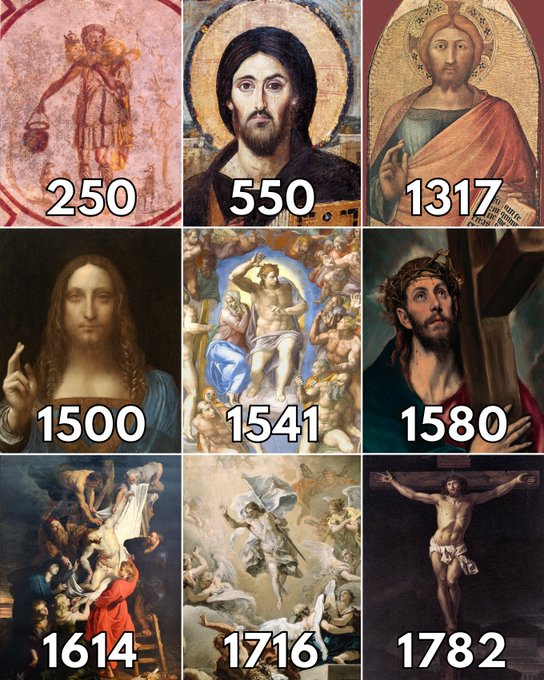Why is Jesus of Nazareth the most painted man of all time?
A journey through depictions of Christ in art... 🧵
571
2K
18K
Replies
In Christianity's infancy, depictions of Jesus were scarce. Like other religions, early Christians were hesitant to be accused of idolatry.
Only once the Incarnation doctrine took hold, acknowledging that God had himself taken on finite, human form, did depictions flourish.
14
38
842
Early icons like the Christ Pantocrator (right hand raised, Bible in the left) established his now-conventional appearance over time - bearded and long-haired.
One famous Byzantine example has lived in a small monastery on Mount Sinai since the 6th century:
12
37
739
The Church began to see art as a way to communicate the Gospel to illiterate congregations.
Catholic prelates across Europe advocated for the creation of art in all its forms, like this 12th century manuscript (Christ remained beardless for a few more centuries in the West):
3
30
539
The Renaissance marked a major shift. Inspired by the lifelike accuracy of classical sculpture, artists like Leonardo Da Vinci pioneered a more naturalistic style.
Christ was shown not before golden backdrops, but grounded in human settings - like in The Last Supper (1498):
2
26
613
But Michelangelo broke with pictorial tradition in The Last Judgment (1541).
He came under fire on several counts: painting Christ beardless, in a scene filled with nudity, mixing pagan mythology with Christian subject matter. He prioritized his artistic ambition over decorum.
6
25
505
A heightened emphasis on the naturalistic came with the Baroque era. Christ was now even more lifelike, with human expressions and deep emotion yielded by dramatic use of light and movement.
The Descent from the Cross by Peter Paul Rubens (1614):
2
22
542
The Protestant Reformation came in the 16th century and objected to public religious images - many were destroyed.
Protestants eventually became more accepting of religious art, but it was smaller, usually confined to book illustrations, and rejected iconic elements like halos:
5
21
412
After the 17th century, Christian art was produced in lesser quantities. But Biblical stories remained a key source of creative exploration for artists as art changed radically.
Rococo works showed him in bright, exuberant settings - The Resurrection by Sebastiano Ricci (1716):
2
22
481
Then, the Neoclassical came back to the emphasis of his virtue and morality, with a more muted use of light and color.
Christ on the Cross by Jacques-Louis David (1782):
1
20
444
Over the centuries, Jesus (often with Mary) became by far the most painted person in history.
Why? Sheer popular demand.
Once unleashed by the Church, religious art was desired for all uses - both mighty church altarpieces and personal works of devotion.
5
27
468
And of course, Christian art benefited from the support of great patrons. Wealthy banking families are responsible for commissioning some of the greatest paintings in history, like Botticelli's Adoration of the Magi (1475):
2
21
451
Like the great churches that housed them, Christian artworks became vehicles of evangelization.
Just as the early Church fathers intended.
6
36
682
@Culture_Crit
The Veiled Virgin is a marble sculpture by Italian artist Giovanni Strazza created in the mid-19th century.
It depicts the Virgin Mary with a delicate veil draped over her head and shoulders, revealing only her serene face and hands.
The sculpture is known for its intricate…
1
11
93
@Culture_Crit
Jesus of Nazareth, being the central figure of Christianity, has been depicted in countless works of art, including paintings, due to the immense influence of Christianity and the significance of his image in religious practice and devotion.
0
1
2
@Culture_Crit
I did not know that he was the most painted man of all time.
Interesting.
Thanks for sharing 🙌
0
0
0
























